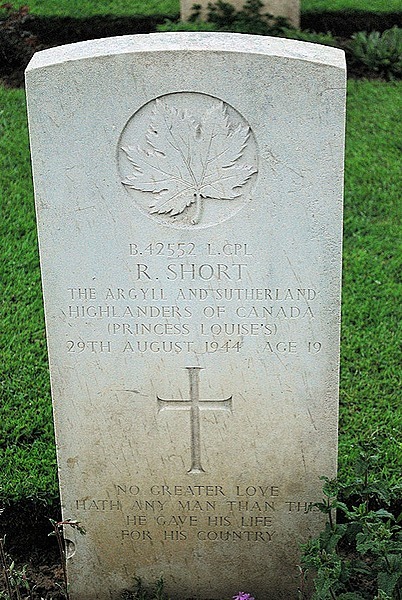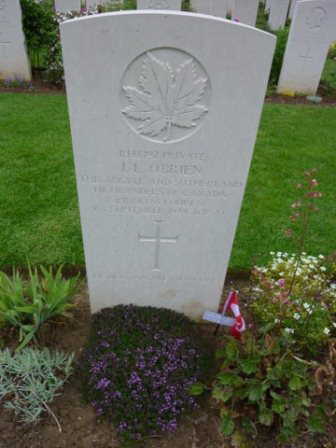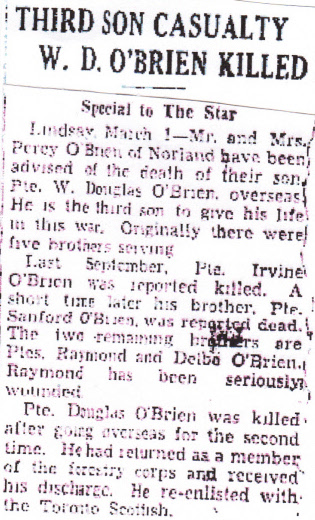L/Cpl Robert Short & Pte Irven Lloyd O’Brien
Introduction
I have a long acquaintance with Argyll KIAs of the Second World War, dating back to 1984 and the beginning of the Black yesterdays project. As the book took form, Pte Jake Leyland, a member of the committee and a veteran, asked me directly (Jake was incapable of anything indirect), “What about the boys, the ones who didn’t come back?” He wanted some sort of recognition of them, and he was right. I thought about a Roll of Honour but decided instead to list the KIAs on the day they were killed. In interviews, veterans would often mention a specific death. Mac MacKenzie often spoke of Chris Jenkinson, for example, and I recently prepared a text for him (with Mac firmly in mind). These memories remain with me, and if someone asks me to recommend a name for commemoration, they come to the fore immediately. Such is the case with LCpl Robert Short. Jim Doyle spoke about him and wrote about him. It has always been in my mind to give him his due. I have often thought that Short would have some appeal to CWO Brian Burns as a “bread and butter Argyll.” I didn’t have the same sort of vivid recollection of Pte O’Brien. Buck Edwards had mentioned him, to be sure. What stuck with me, however, was his parents’ terrible loss. The film Saving Private Ryan (1998) brought O’Brien and his two brothers to mind. The loss of one son is surely bad enough, but three always seemed beyond, far beyond, the pale!
Robert L. Fraser
Regimental Historian
Death in battle is different, Sam Chapman thought:
“He is cut down in an instant with all his future a page now to remain forever blank.
There is an end but no conclusion.”
– Capt Sam Chapman, C and D Coys
L/Cpl Robert Short (B 42552) (1925-44)
KIA 28 August 1944
Pte Jim Doyle, Scout Platoon, never forgot Bob Short: “I always remember Bob because he pressed O’Brien and I’s uniform that night before we went AWOL.” But there was more to Doyle’s remembrance: “He was just that good kid … he had joined the army at fourteen. They caught him; he was kicked out at fifteen. He re-enlisted with the Argylls at sixteen; he was killed at seventeen … that’s Argyll, bread and butter Argyll!”
Short’s obituary in a Brantford newspaper would tell a similar tale:
“Most boys of 15, during wartime, dream of joining the Army. Few realize their dream for at least three years, but L/Cpl Robert Short followed his dream even to death … His joy was well-nigh boundless. Not only was he seeing the world, but he was in the Army, and he had the greatest admiration and regard for this branch of the service. He endured hardships with characteristic good nature…. Into his brief life, which ended when he was 19, he had crowded more adventures than do most people in the allotted three score years and ten.”
Bob Short’s family emigrated from Durham, England, and settled in Brantford. He worked as a labourer and had five months in 1940 in the Dufferin and Haldimand Rifles. Two of his older brothers (James and William, KIA Oct. 1944) had enlisted and he did as well, lying about his age. His service record reveals a handful of the usual sort of minor infractions (AWOL, failure to obey an order, and once falling asleep while on sentry duty). Short enjoyed the unit’s time in Nanaimo, B.C., and then Jamaica. He was with “C” Coy in Lt Alf Henderson’s platoon.
After the early fighting at Tilley and then Hill 195, he was promoted LCpl. He wrote to his sister Gladys on 13 Aug. 1944; he had just heard he was “now an Uncle five times at the age of nineteen. I also have a surprise for you I have been promoted to L.Cpl.” He conveyed news of his brother Jim, whom he had seen on 11 Aug., and had a letter from brother Bill. He offered his love to everyone “and God Bless You.” He added: “But in the event that I get killed I have you down as my next of kin. So you and Alex can split it [his savings of ‘about’ $220] between you.” The coming days brought heavy action. “B” and “C” Coys were at St. Lambert, which CSM George Mitchell described as “explosions terrific, shelling still heavy – town lit up in flames … We have more casualties.” The breakthrough followed and its grisly scene: “stench terrific, death + destruction to Germany.” At Igoville on the 27th, Lt Henderson was killed while leading his platoon against snipers; on the 28th, there were more casualties with the successful assault on Hill 95 supported by SAR tanks at 1930 hours. Bob Short was one of them. Wounded in the lower left chest, his condition was initially “fair,” but it worsened and he “died immediately and suddenly” on the 29th. Short’s adventure was over. He left little, but among his personal effects were “5 cap badges.” Doyle was right – “bread and butter Argyll.”
Remembered with respect – an Argyll.
Note: L/Cpl Short’s poppy (with this text) will be mounted is in the virtual Argyll Field of Remembrance in the near future. The Argyll Regimental Foundation (ARF) commissioned Lorraine M. DeGroote to paint the Argyll Poppy (top) for the Field of Remembrance.
Pte Irven Lloyd O’Brien (B 148792) (1922-44)
Died 1 September 1944
Born in Norland, Ont., on 17 Jan. 1924 to parents of Scottish background, Irven (sometimes spelled Irvine) O’Brien was the 7th of 13 children. Home life was “good.” He left school after grade 7 “because he was needed on home farm.” His father also owned a “large hunting camp,” where he worked as a “hunting guide.” After a year on the farm, he was employed for one year at the Olympia Tea Room in Lindsay and then three and a half years as a wood worker at Allan Wood Products in Fenelon Falls. Until the war, the firm made wooden Tinkertoys and then converted to manufacturing rifle butts for the war effort. “Interested in baseball (catcher) and fishing, hunting is his main enthusiasm and he seems to be a good marksman. Fond of motor mechanics he owns his own Model T Ford and keeps it in running repair.” He also enjoyed skiing, skating, and swimming. He was with the 56th Field Battery for five months in 1941, enlisting on 29 June 1943: A “shy, reserved manner but is very co-operative … clean bright appearance, a good build and average intelligence.” “Previously rejected … for a hernia, this has been remedied and he is now in A-I category although he states that he is sometimes bothered by his stomach … His four older brothers are all Overseas.”
An assessment in Sept. 1943 recommended the continuance of training, noting that he “makes no complaints.” After the completion of basic training and making “satisfactory progress,” the army deemed him suitable for “Operational” overseas service and recommended him for “Pioneers.” For his part, he preferred to be a “Carpenter” or “Machine gunner.” Overseas in Feb. 1944, an interviewing officer found him: “Pleasant mannered, tall well-built lad. Seems brighter than score suggests, is neat, polite with good attitude to army.” He was 5’, 10½”, 156 lb, with hazel eyes and fair hair. He joined the Argylls on 13 March 1944. His older brother, Ray, had been with the unit from mobilization. Irven was posted to 17 Platoon, “D” Coy. Pte Buck Edwards of “D” remembered that when “D” landed in France, “we got out and never even got our feet wet. Big OB [O’Brien] started to complain about it and little Tommy [Nangle] shoved him off the back into the water … it was hilarious at times and serious at other times.”
The “serious times” came quickly and “D” saw considerable action. After Hill 195, Irven fought at Igoville on 27 Aug., then during the attack supported by SAR tanks on the high ground beyond it (Hill 95) the next day. He came through the heavy fighting there unhurt. Then, on 29 Aug. at 1500 hours, the battalion moved uneventfully to Boos, a large town. But even sporadic, indirect fire could prove fatal. That night two mortar bombs hit an SAR tank and there were casualties: Irven O’Brien was one of them; he died of “a shell fragment wound with a fracture of the left hip” on 1 September. He was the first of three sons lost to his parents: the second, Pte Sanford O’Brien, was KIA on 17 Sept. 1944 with the Irish Regiment, and the third, Charles Douglas O’Brien, on 18 Feb. 1945 with Toronto Scottish. His brother Ray (Scout Platoon) was wounded at Moerbrugge on 9 Sept. 1944. For O’Brien’s parents, their war was all too serious and written in the blood of their sons.
In September 1944 a newspaper reported that O’Brien: “… was a very likeable chap and a general favourite with all who knew him … Mr. and Mrs. O’Brien have been justly proud of their five stalwart Sons who enlisted in true Canadian style to their country’s call.”
Respectfully remembered by an Argyll.
Note: Poppies for Pte O’Brien and L/Cpl Short will be mounted in the virtual Field of Remembrance in the near future. The Argyll Regimental Foundation (ARF) commissioned Lorraine M. DeGroote to paint the Argyll Poppy for the Field of Remembrance.
Between 28 August and 1 September, 5 Argylls were killed in action (or died from wounds), 8 were wounded, and 3 were POWs.
“a history bought by blood” – Capt Sam Chapman, C and D Coys
Robert L. Fraser
Regimental Historian

 L/Cpl Robert Short
L/Cpl Robert Short
 L/Cpl Short’s gravestone in Bretteville-sur-Laize, Canadian War Cemetery, France.
L/Cpl Short’s gravestone in Bretteville-sur-Laize, Canadian War Cemetery, France.
 Pte Irven Lloyd O’Brien’s military gravestone at Beny-sur-Mer, Canadian War Cemetery, France.
Pte Irven Lloyd O’Brien’s military gravestone at Beny-sur-Mer, Canadian War Cemetery, France.
 Pte O’Brien’s grave marker in Norland, Ont.
Pte O’Brien’s grave marker in Norland, Ont.
 Toronto Star, 2 March 1945.
Toronto Star, 2 March 1945.